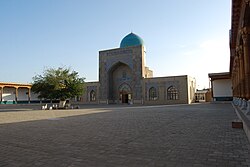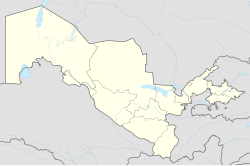Qarshi
|
Qarshi Қарши |
|
|---|---|

Kok-Gumbaz mosque in Qarshi
|
|
| Location in Uzbekistan | |
| Coordinates: 38°52′N 65°48′E / 38.867°N 65.800°ECoordinates: 38°52′N 65°48′E / 38.867°N 65.800°E | |
| Country |
|
| Region | Qashqadaryo Region |
| Population (1999) | |
| • Total | 197,600 |
Qarshi (Uzbek: Qarshi / Қарши; Persian: نخشب / Nakhshab; Russian: Karshi / Карши) is a city in southern Uzbekistan. It is the capital of Qashqadaryo Region and has a population of 197,600 (1999 census estimate). The population of Qarshi on April 24, 2014 is approximately 222,898. It is about 520 km south-southwest of Tashkent, and about 335 km north of Uzbekistan's border with Afghanistan. It is located at latitude 38° 51' 48N; longitude 65° 47' 52E at an altitude of 374 meters. The city is important in natural gas production, but Qarshi is also famous for its production of woven flat carpets.
Originally the Sogdian city of Nakhshab, and the Islamic Uzbek (Turkic) city of Nasaf, and the Mongol city of Qarshi (pronounced Kharsh), Qarshi was the second city of the Emirate of Bukhara. It is in the center of a fertile oasis that produces wheat, cotton, and silk and was a stop on the 11-day caravan route between Balkh and Bukhara. The Mongol Chagataid khans Kebek and Qazan built palaces here on the site of Chinggis Khaan's summer pasture. In 1364, Timur also built a fortified palace with moats in what is now the southern part of the city. The modern name "Qarshi" means fort.
...
Wikipedia

